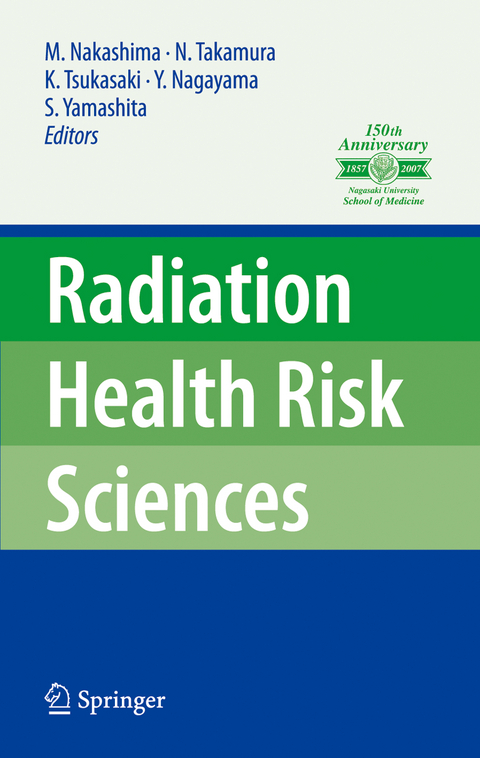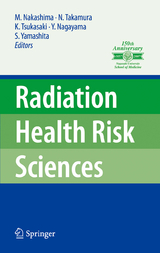Radiation Health Risk Sciences
Overview of the Global COE Program.- Global Strategic Center for Radiation Health Risk Control.- Overview of the Lectures.- Discussion on Points of Radiation Safety and the Scope of The University of Tokyo Global COE Program.- Network System for Radiation Emergency Medicine in Japan and the Role of Hiroshima University.- Non-DNA-Targeted Effects and Low-Dose Radiation Risk.- Update from the Chernobyl Tissue Bank: Effect of Latency on Different Types of Thyroid Cancer Post-Chernobyl.- Current Risk Estimate of Radiation-Related Cancer and Our Insight into the Future.- Atomic Bomb Disease Medicine.- of Atomic Bomb Disease Medical Research in Global COE Program.- The Offspring of Atomic Bomb Survivors: Cancer and Non-Cancer Mortality and Cancer Incidence.- Ischemic Heart Disease Among Atomic Bomb Survivors: Possible Mechanism(s) Linking Ischemic Heart Disease and Radiation Exposure.- Leukemia, Lymphoma, and Multiple Myeloma Incidence in the LSS Cohort: 1950–2001.- Follow-Up Study of 78 Healthy Exposed Atomic Bomb Survivors for 35 Years in Hiroshima, with Special Reference to Multiple Cancers.- International Radiation Health Sciences.- Research Activities and Projects Within a Framework of International Radiation Health Sciences Research.- Age and Prognosis: Do Adjuvant Therapies Influence the Real Prognosis?.- Mortality of the Chernobyl Emergency Workers: Analysis of Dose Response by Cohort Studies Covering Follow-Up Period of 1992–2006.- Twenty Years After Chernobyl: Implications for Radiation Health Risk Control.- Fallout Exposure of the Population and Thyroid Nodular Diseases.- Radiation Basic Life Sciences, Part 1.- Higher-Order Chromatin Structure and Nontargeted Effects.- p53 Dependency of Delayed and Untargeted Recombination in Mouse Embryos Fertilized byIrradiated Sperm.- The Yin and Yang of Low-Dose Radiobiology.- Induction and Persistence of Cytogenetic Damage in Mouse Splenocytes Following Whole-Body X-Irradiation Analysed by Fluorescence In Situ Hybridisation. V. Heterogeneity/Chromosome Specificity.- Cancer Research.- Molecular Understanding of RET/PTC-Mediated Thyroid Carcinogenesis.- Molecular Prediction of Therapeutic Response and Adverse Effect of Chemotherapy in Breast Cancer.- Multiple Roles of NBS1 for Genotoxic and Nongenotoxic Stresses.- Radiation Basic Life Sciences, Part 2.- The DNA Damage Response in Nontargeted Cells.- The Role of Telomere Dysfunction in Driving Genomic Instability.- Secretory Clusterin Is a Marker of Tumor Progression Regulated by IGF-1 and Wnt Signaling Pathways.- Target of Radiation Carcinogenesis Is Protein: Becoming Triploid Is Proximate Cause of Cell Transformation.- Adult Stem Cells, the Barker Hypothesis, Epigenetic Events, and Low-Level Radiation Effects.- Combined Effect of Ionizing Radiation and N-Ethyl-N-Nitrosourea on Mutation Induction and Lymphoma Development.- ?-Ray-Induced Mouse Thymic Lymphomas: Bcl11b Inactivation and Prelymphoma Cells.- Radiation Risk Management.- Framework of Radiation Safety Management in Japan: Laws, Administrative Agencies, and Supporting Associations.- Background Radiation Dose to the Population Around the Kudankulam Nuclear Power Plant.- International Cooperation in Radiation Emergency Medical Preparedness: Establishment of a Medical Network in Asia.- Disaster and Mental Health.- Long-Term Biopsychosocial Consequences of Disaster: Focus on Atomic Bomb Survivors.- Health Status of Children Exposed to the Chernobyl Accident In Utero: Observations in 1989–2003 and the Implications for Prioritizing Prophylactic Programs.- PsychologicalConsequences More Than Half a Century After the Nagasaki Atomic Bombing.- Radiation and Cancer.- Significance of Oncogene Amplifications in Breast Cancer in Atomic Bomb Survivors: Associations with Radiation Exposure and Histological Grade.- Paracrine Interactions Between Normal, but Not Cancer, Epithelial and Normal Mesenchymal Cells Attenuate Radiation-Induced DNA Damage.- Chernobyl and Semipalatinsk Nuclear Test Sites: Related Issues.- Thyroid Cancer in Ukraine After the Chernobyl Accident: Incidence, Pathology, Treatment, and Molecular Biology.- Current Trends in Incidence and Mortality from Thyroid Cancer in Belarus.- The Health Status of the Population in the Semey Region and Scientifically Proven Measures to Improve It.- Nuclear Explosions and Public Health Development.
From the reviews:
“This book, the proceedings from a 2008 international symposium hosted by the center, outlines proper collection and analysis of biological samples, the role and significance of radiation-pertinent cancer research, the significance of psychological effects, and a host of other topics including the need for emergency radiation medicine given the occurrence of an accident. … The book has an obvious audience among protective specialists. … the audience is considerably broader and likely encompasses clinicians, researchers, and practitioners.” (J. Thomas Pierce, Doody’s Review Service, December, 2009)
| Erscheint lt. Verlag | 22.12.2008 |
|---|---|
| Zusatzinfo | 1 Illustrations, color; 54 Illustrations, black and white; XXXVI, 340 p. 55 illus., 1 illus. in color. |
| Verlagsort | Tokyo |
| Sprache | englisch |
| Maße | 155 x 235 mm |
| Themenwelt | Medizinische Fachgebiete ► Radiologie / Bildgebende Verfahren ► Radiologie |
| ISBN-10 | 4-431-88658-3 / 4431886583 |
| ISBN-13 | 978-4-431-88658-7 / 9784431886587 |
| Zustand | Neuware |
| Haben Sie eine Frage zum Produkt? |
aus dem Bereich




